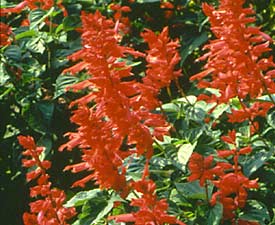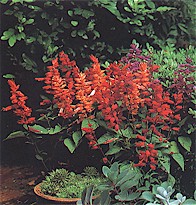| Salvia
 The bold colors and striking texture of salvias create
instant focal points in the garden. Also known as scarlet sage, the sturdy plants do not
need staking, only occasional pinching back to keep more flowers coming. Bright red
salvias can be seen from far away, or you might use some of the newer colors, such as
salmon, to bring dramatic color to partial shade. Salvias have a strong upright growth
habit that works well with formal landscaping styles. Not to be confused with perennial
salvias, the annual salvias will bloom continuously from the time they are planted until
frost. The bold colors and striking texture of salvias create
instant focal points in the garden. Also known as scarlet sage, the sturdy plants do not
need staking, only occasional pinching back to keep more flowers coming. Bright red
salvias can be seen from far away, or you might use some of the newer colors, such as
salmon, to bring dramatic color to partial shade. Salvias have a strong upright growth
habit that works well with formal landscaping styles. Not to be confused with perennial
salvias, the annual salvias will bloom continuously from the time they are planted until
frost.
Care
 When planting salvias in beds, cultivate the
planting site at least 8 inches deep, and mix in a 2-inch deep layer of flower planting
mix, compost, or other type of organic matter. Just before planting, mix in a
timed-release fertilizer that has a high middle number in the fertilizer analysis, such as
11-40-6. The extra phosphorous helps the plants develop extensive roots. When planting salvias in beds, cultivate the
planting site at least 8 inches deep, and mix in a 2-inch deep layer of flower planting
mix, compost, or other type of organic matter. Just before planting, mix in a
timed-release fertilizer that has a high middle number in the fertilizer analysis, such as
11-40-6. The extra phosphorous helps the plants develop extensive roots.
In midsummer, you can rejuvenate your
salvias by cutting back old flower spikes and fertilizing the plants. Use sharp pruning
shears to remove withered spikes. Then fertilize your salvias with 17-17-17 with
timed-release fertilizer. Sprinkle this "booster feeding" into the soil between
the plants and water well. When growing salvias in containers, fertilize them more often
by sprinkling a teaspoon of fertilizer per plant atop the soil in the pots about once a
month.
|
